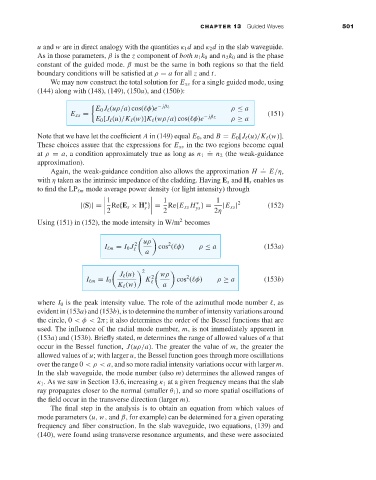Page 519 - Engineering Electromagnetics, 8th Edition
P. 519
CHAPTER 13 Guided Waves 501
u and w are in direct analogy with the quantities κ 1 d and κ 2 d in the slab waveguide.
As in those parameters, β is the z component of both n 1 k 0 and n 2 k 0 and is the phase
constant of the guided mode. β must be the same in both regions so that the field
boundary conditions will be satisfied at ρ = a for all z and t.
We may now construct the total solution for E xs for a single guided mode, using
(144) along with (148), (149), (150a), and (150b):
E 0 J (uρ/a) cos( φ)e ρ ≤ a
$ − jβz
E xs = − jβz (151)
E 0 [J (u)/K (w)]K (wρ/a) cos( φ)e ρ ≥ a
Note that we have let the coefficient A in (149) equal E 0 , and B = E 0 [J (u)/K (w)].
These choices assure that the expressions for E xs in the two regions become equal
.
at ρ = a,a condition approximately true as long as n 1 = n 2 (the weak-guidance
approximation).
.
Again, the weak-guidance condition also allows the approximation H = E/η,
with η taken as the intrinsic impedance of the cladding. Having E s and H s enables us
to find the LP m mode average power density (or light intensity) through
1 1 1
∗
| S | = Re{E s × H } = Re{E xs H }= |E xs | 2 (152)
ys
∗
2 2
s 2η
2
Using (151) in (152), the mode intensity in W/m becomes
2
I m = I 0 J 2 uρ cos ( φ) ρ ≤ a (153a)
a
J (u) wρ
2
2
I m = I 0 K 2 cos ( φ) ρ ≥ a (153b)
K (w) a
where I 0 is the peak intensity value. The role of the azimuthal mode number ,as
evident in (153a) and (153b), is to determine the number of intensity variations around
the circle, 0 <φ < 2π;it also determines the order of the Bessel functions that are
used. The influence of the radial mode number, m,is not immediately apparent in
(153a) and (153b). Briefly stated, m determines the range of allowed values of u that
occur in the Bessel function, J(uρ/a). The greater the value of m, the greater the
allowed values of u; with larger u, the Bessel function goes through more oscillations
over the range 0 <ρ < a, and so more radial intensity variations occur with larger m.
In the slab waveguide, the mode number (also m) determines the allowed ranges of
κ 1 .Aswesaw in Section 13.6, increasing κ 1 at a given frequency means that the slab
ray propagates closer to the normal (smaller θ 1 ), and so more spatial oscillations of
the field occur in the transverse direction (larger m).
The final step in the analysis is to obtain an equation from which values of
mode parameters (u, w, and β, for example) can be determined for a given operating
frequency and fiber construction. In the slab waveguide, two equations, (139) and
(140), were found using transverse resonance arguments, and these were associated

